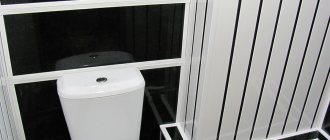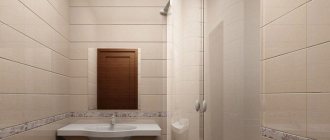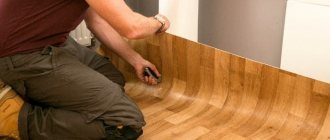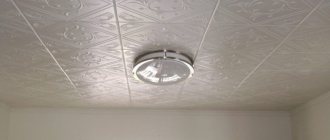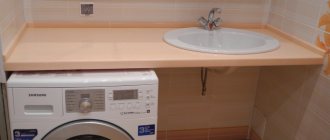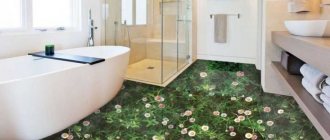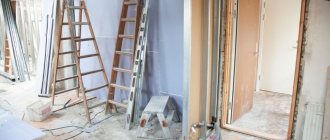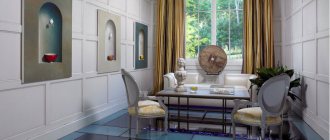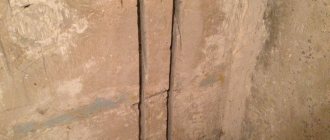My name is Kirill, I am a specialist in the field of finishing residential and non-residential premises, in today’s article I will tell you about all the intricacies of finishing a bathroom with PVC panels, I will share my experience and tips.
Have questions ? Call!
For finishing a bathroom, one of the most budget-friendly, but no less effective materials is considered to be a plastic panel. The article reflects its varieties, strengths and weaknesses, and discusses the specifics and types of installation. There is also a gallery with examples of work.
For your information
If you want to create a unique design and need simple installation, then finishing the bathroom with plastic panels is the most suitable option.
Pros and cons of using plastic panels
This material is very popular and in demand. And before using it for the bathroom, study its strengths and weaknesses:
Strong:
- Simplicity of installation and dismantling work.
- Affordability.
- Aesthetic characteristics, elegant appearance, various textures.
- Resistance to temperature changes.
- Repel odors
- Masking of communications.
- Resistance to moisture and water.
- Hygiene. Resistance to bacteria.
- Durability.
- Easy to maintain.
- Non-flammability.
Weak:
- No breathability. There is no throughput potential.
- Melting when burning. This releases hazardous elements.
- Unsuitable for use in corridors and escape routes.
- Destructible from washing with hard brushes.
- Susceptibility to mechanical stress and ultraviolet radiation.
- Modest level of sound and heat insulation.
For your information
Although today, thanks to modern technologies, this material is being improved, emits less pungent odor and meets high fire safety criteria.
Types of PVC panels
If you intend to cover your bathroom with plastic sheets, you should decide on their types:
- Wall. The most common. Also suitable for ceilings, only here thinner modifications are used (density up to 5 mm). For walls we use stronger versions. Their thickness lies in the range of 7 -12 mm. These types have a huge range of colors, images, textures and imitations of other coatings, such as wood.
Their geometric shape is an elongated rectangle. In the design, two parts are connected by ribs. There are locks along the edges for fastening together.
- Tiled. Shapes: square, rectangle. There are versions with and without connecting pins; with one or many layers; flat and swollen; with and without adhesive base; with decorative components and imitation of other materials. This type has a wide choice of external texture and better strength due to smaller parameters.
- Lining. Imitates the appearance and width of real lining. The length is 6 m.
Structure: two layers that hold the lintels together; there is a locking mechanism, as in item 1.
The assortment includes products of various tones and colors. The seam is always visible.
The material is durable and versatile. I recommend it for laying long lines horizontally.
- Leafy. They have a texture that creates an imitation of tiles or mosaics. There are variations with plot and photographic images.
The material is characterized by relief, which duplicates the appearance of wood, brick and other materials. It doesn't have a docking lock. It must be mounted on a smooth base, usually with glue. The process is easy and fast.
The bathroom can be decorated with plastic panels on the walls and ceiling. Use any type you like and that is suitable, taking into account the quality, external texture and installation method.
It is important to do everything correctly, here are some articles for you
How to glue wallpaper correctly. The foreman shares his experience. Finishing work. Stages of finishing work. How can you save money when renovating?
to size
Wall models have different thicknesses, but better preserve the geometry of the version with a parameter of 7-8 mm. The optimal length is 2.5 - 3 m. Width - 25 - 37.5 cm. Sheet modifications have a length of 98 - 120 cm, width - 48 - 98 cm, density - 3-5 mm.
Tiled ones most often have a square shape, and their sides are equal. Dimensional variations range from 30 to 100 cm. In single-layer products the density is 3 mm, in structural products it is 15 mm. Lining can be purchased in the following parameters: width – 10 cm, length – up to 6 m, thickness – 8-10 mm.
Facial image strength
Before installing PVC panels in the bathroom, I recommend studying their types according to the indicated criterion:
Thermal printing. Used in 80% of products. The film is transferred thermally. And the image appears on the outside of the lamella. The print replaces the varnish, creating a smooth base. For this reason, the models do not require varnishing. They are susceptible to wear and sunlight. I recommend using them in rooms protected from the sun and in a temperate climate. Examples: utility rooms, dressing rooms, corridors. These types have a variety of painting palettes. And this is their main advantage.
- Offset printing. Here the engraving is copied with a roller and rolled along the outer plane. This creates the appearance of marble, but does not produce distinct figures.
Strengths: high wear resistance: significant texture retention period (10 years); no fading; the presence of relief and an elegant outer layer.
- Laminated models. They are distinguished by the highest strength and price. The outer area is finished as follows: a painted, textured and structural film is glued. It forms a defensive layer from external aggressive influences. And the product is endowed with increased wear resistance and is suitable for use in any room.
- Plain. They may or may not be varnished. They come in matte and semi-matte finishes. Typically used for ceilings.
The unvarnished subspecies are the least durable. They also quickly fade from the sun, nicotine and other air impurities.
Lacquered options have a decorative function and are resistant to such influences, and have a long service life.
- Products to which coloring pigments are added directly during the production process. Since the entire mass is covered with paint and there are no decorative components, they are characterized by durability. They may have a varnished finish.
Have questions ? Call!
Preparation and calculation
Before starting repairs, preparatory measures will be required. This stage should be approached responsibly, since the service life of the plastic panels depends on the preparation. Before installing wall and ceiling products yourself, you will need to prepare the base.
The process consists of the following steps:
- All dust deposits and dirt must be removed from the base. The seams are thoroughly cleaned using a spatula or other tools. Then the base will need to be treated with antifungal and bactericidal mixtures. The entire surface needs to be treated.
- You will also need to apply the mixture to the seams and corners. Due to such actions, the profile and the wall will not be subject to the formation of various types of fungi. After treatment, you need to allow the surface to dry. Excess moisture on the walls and ceiling is not allowed.
- To ensure that cladding with plastic panels is not accompanied by difficulties, you should cut the material before work and measure plumbing fixtures in order to calculate the required dimensions of the products. Accurate calculations are necessary for the economy option, when there is no extra money to purchase additional materials.
Before installation, you will need to clarify how much finishing material you need to purchase. To do this, you need to know the area of the walls and the dimensions of the panels. The surface area is calculated simply by multiplying the height and width of the walls. The cladding material is offered by manufacturers in standard sizes, according to which the width is 0.25 meters and the length is 3 meters. For example, if the bathroom is 2 meters wide, then only 8 panels are needed for the cladding.
How to choose high-quality PVC panels
When you plan to cladding a bathroom with plastic panels, you need to choose these products wisely.
When choosing a coloring, you should read the parameters of the room. If they are modest, then I advise you to take canvases in lighter colors with variations of wood or tile imitations. Models with simple white flowers are also allowed.
Due to the dark color, the space is visually reduced. And the presence of bright tones causes excitability and rage.
Finishing a bathtub with plastic panels should be done only with high-quality materials. To choose them correctly, you should be based on the following criteria:
- The position of the ribs is at a distance of 1 cm. The density of the front side is at least 1 mm.
- Is there any bleed through of internal partitions? In a product of poor quality this is very noticeable.
- Presence of a pungent odor. This is a sign of a cheap version.
- Translucent front plane. A good quality model should not have it. Such versions can be mounted on the ceiling and walls of non-residential premises.
- Presence of defects, cracks, deformations and scratches.
- Identity of parameters and connections of products.
- Monochromatic pictures.
- Colors, relief variations. These factors can visually develop the space.
Important
If you want to cover the walls of the bathroom with PVC panels in 3D format, then keep in mind that it is very difficult to maintain the usefulness of the image of these versions. The reason is that very precise merging of their joints is required.
It is important to do everything correctly, here are some articles for you
How to glue wallpaper correctly. The foreman shares his experience. Finishing work. Stages of finishing work. How can you save money when renovating?
Sheathing using frame technology
A more familiar and common option is finishing the bathroom with plastic panels and constructing a frame. This allows you to fix the cladding without first leveling the walls, and also to hide all communications behind the cladding.
Required tools and materials
To carry out the work you will need:
- perforator;
- dowels and screws;
- wooden beam for mortgages;
- guide and rack metal profile;
- straight hangers;
- polyurethane foam;
- corrugation for electrical wiring.
Preparing the walls
Wall preparation involves dismantling the old finish and sealing large defects that affect the load-bearing characteristics of the partitions. Additionally, the walls are treated with a deep-penetrating primer for mineral surfaces with antiseptic additives.
Also at this stage, water and sewer pipes are laid out, electrical wiring is laid to sources of consumption.
Note! The electrical wire is laid in a corrugated tube, which is attached to the base (wall or ceiling) with special clamps.
Frame installation
To construct the sheathing, a galvanized profile for plasterboard is used, since wooden blocks are susceptible to rotting and warping when used in wet conditions.
The frame posts are mounted in the corners of the room and secured to the wall using direct hangers.
Horizontal jumpers are attached to the vertical posts in increments of 40–60 cm, to which the plastic trim will subsequently be attached. To connect profiles at an angle of 90°, the edge of the profile is cut and placed on the top shelf of the guide and attached to it with self-tapping screws.
In places where attachments are installed: cabinets, shelves, heated towel rail attachments, and so on, additional jumpers (mortgages) are provided. To ensure that the fastening of the equipment is as reliable as possible, it is recommended to reinforce the profile with a wooden insert, which is fixed with self-tapping screws.
A frame for the box is also assembled around the riser.
Advice! To give additional rigidity to the frame in places where any elements are attached, it is recommended to foam the space between the mortgage and the wall. You can also foam the corners: this will make the frame less noisy.
A similar frame structure is assembled on the ceiling base for its cladding.
Installation of PVC cladding
The bathroom trim starts from the ceiling. Along the perimeter, a starting profile is attached to the metal guides, into which the edges of the panels are inserted. The strips are attached to the cross members of the frame with self-tapping screws and a press washer. To ensure that the junction of the panels is minimally noticeable, they are tightly connected to each other.
But there are models with a selected edge, which, after joining two strips, forms a V-shaped seam. Therefore, when choosing a material, you need to pay attention to this nuance.
After covering the ceiling, they begin to install the plastic on the wall frame:
- The starting strip is fixed at the bottom and top. It can be glued to the floor covering with silicone to create a sealed joint.
- The panels are inserted into the grooves of the starting profile and fixed to the frame with self-tapping screws.
- When connecting two panels in the corner of a room, use a corner profile.
To make the finish look cohesive, the outer stripes of one row must have the same width. This is calculated before the first strip is attached. Another option to decorate a corner beautifully is to bend the panel and attach it without using additional corners.
To do this, 2-3 cm is cut out from the back side of the plastic (the front part should remain intact). After this, the panel can be easily bent in the desired direction to form an outer or inner corner.
Tips for choosing panels
Before purchasing, you need to imagine the design of the room and focus on a specific idea, taking into account the features of the room.
Basic recommendations
- For a small bathroom, it is appropriate to choose light shades, thus increasing the visual volume of the room;
- An interesting solution is the arrangement of plastic panels of different sizes and designs. For example, you can combine contrasting tones;
- The wooden texture will allow you to decorate the room in an ethno style;
- You should not combine polyvinyl chloride cladding with expensive materials, such as marble. In this case, the interior will turn out tasteless;
- If desired, you can choose plastic panels for tiles. Thus, the decoration of the bathroom can be done in a classic or neoclassical version - with columns, friezes and borders;
- Photo printing allows you to create an individual design, thanks to modern paint application technologies;
- Sheathed walls go well with slatted ceilings.
Disadvantages and advantages of plastic panels
Plastic panels are an affordable and modern material with which you can decorate your bathroom with high quality and style. The material has the following advantages:
- as a facing material, plastic melts only at a temperature of 400 degrees;
- environmentally friendly and safe;
- can last a long time without visible damage;
- the structure of the plastic will not be damaged even with prolonged exposure to moisture;
- easy to maintain and clean;
- there are no conditions for the growth of fungi and bacteria;
- there is no need to use special cutting tools;
- there is a wide range of colors and textures on the market;
- simplicity and speed of repair work when the need arises;
- affordable price.
However, this type of finishing also has a number of disadvantages:
- It is imperative that the installation be carried out correctly; if the work was carried out with errors, the material may diverge during operation;
- even with minor mechanical impact, traces may remain on the surface;
- release of toxic gas during fire; may be inferior to tiles in terms of external characteristics;
- When using such panels, it is necessary to ensure good ventilation to avoid the appearance of fungus and mold.
Equipment and additional elements
PVC panels in the bathroom are installed normally if they are fully equipped. It should contain the following components:
- Corner 1: universal. Externally, it is a plate bent at a right angle. Used in finishing external and internal corners.
- Skirting for floor and ceiling. We partially place it under the panels. The outer part masks surface defects.
- Corner 2: external. The width of the inner part is greater than the width of the outer part. Hides uneven areas of the outer corner well.
- Corner 3: internal. We place its wide side under the slats. And the narrow one on the outside hides uneven places in the inner corners.
- Profile 1: connecting. Thanks to it, we make a lockless connection between the panels. This is true when their length is not enough for finishing work.
- Profile 2: initial and finishing. We install at the beginning and at the end.
- Profile 3: F-shaped. We put it in the junction areas, we can use it as a platband.
- Mounting sheathing strip. This load-bearing frame component. Its material: plastic or metal profile.
- Klyammer. A metal element that presses the panel to the bar. Thanks to it, we dismantle products without compromising factory characteristics.
Depending on the method of fixing the panels, you must have:
- self-tapping screws with a press washer,
- staples,
- stapler,
- liquid nails.
The scheme for using the components is as follows:
How to calculate the number of panels and additional elements
Working with PVC panels in the bathroom begins with calculating their number and additional components. We take into account the specifics of this room: different transitions, an abundance of corners, etc. The more there are, the more unused waste is generated, especially when working with panels with decorative images or asymmetrical patterns.
For other models, we increase their number by 15% of the working surface area.
For an accurate calculation, we take measurements of the total length:
- external and internal corners,
- ceiling and floor plinths.
Solving dilemmas with profiles:
- How much starting product will be needed?
- Will a linking view be needed?
- What components will be used to finish the corners: simple or complex?
Advice
If you have experience working with similar panels, use simple corners; if you don’t have the skills, use complex options. They hide cutting imperfections or sizing errors.
When calculating the slats and mounting strips, we take into account the required distance between them - a maximum of 50 cm. We fasten them in areas where the floor and the flow meet, bringing them as close as possible to all corners and openings. We place the slats here regardless of the positions of the final row.
It is never possible to carefully calculate clamps or screws. We immediately purchase them in large quantities.
Mounting methods
How to attach plastic panels in the bathroom depends on the chosen installation method. Their list is as follows:
- For clamps.
- To the sheathing.
- On a metal frame.
- Without it (item 3).
- On glue.
Fastening with mounting clamps
Installation of plastic panels in the bathroom using this method is as follows: the panels are attached to the sheathing, which is formed by plastic slats, using special “locks”. Due to them the process goes much faster.
This method is usually used in rooms with a large area. The overlay strips cover some centimeters, but this is not noticeable here.
Pros:
- Quick installation.
- High-quality hiding of defects.
Minuses:
- The need for sheathing.
- The method is effective only in large rooms.
Attaching to wood sheathing
Here the fixation does not take place with a special frame. We use a stapler or simple nails.
The advantages of this technique:
Effectively hide communications and uneven areas. To do this, we create a separate box.
Minuses:
The need to treat the sheathing with special protective compounds.
Installation on a metal frame
Installing plastic panels in the bathroom requires removing all foreign objects from the room, as well as plumbing fixtures. The reason is that the work affects all wall surfaces.
After this, we measure the height of the walls from the extreme points: from floor to ceiling. Based on the obtained indicators, we cut the profile to make a frame.
Here the sheathing under the panels should be plastic or metal, due to the serious humidity of the room. The wooden version is also suitable, but only painted and specially treated.
We install the slats, maintaining a step of 40 cm. We move the wall and ceiling away by a maximum of 40 -50 cm. For fixation, we use a level and a stapler.
The panels are mounted vertically. This makes the room visually more spacious.
We also cover the areas where plumbing fixtures are located with panels so as not to deteriorate the overall style of the room.
Finishing the bathroom with plastic panels starts from the corner that is furthest from the doorway.
We display products using a level. And we fix them with self-tapping screws.
After installing the panels, fill all joint areas with sealant.
This method has the same advantages as the option with wooden sheathing, but no special processing of the frame is required.
Frameless installation
With this method, we first prime the walls. In our work we use liquid nails for PVC panels. This is a special glue. And its consumption per 5 sq.m is 1-3 cans. The more curvature on the walls, the more it is wasted.
We remove differences with a parameter greater than 3 mm. This is sufficient for the planned installation.
Next we cut the material. How to cut PVC? An ordinary hacksaw with a wood blade will do here.
After this, we apply liquid nails pointwise to the panels in a checkerboard pattern.
We retreat 5-10 cm from the edge of the panel. This way the glue will not spread.
How to glue the panels correctly? We apply the products to the wall and gently press them down and immediately remove them from the wall for 6-7 minutes. So the panel dries out, and we return it to the wrong place.
Advantages of the method:
- Saving effort and money.
- Saving usable space.
Minuses:
- There is a certain preparation of the walls, but only large slopes, more than 3 mm, are removed.
- Does not hide communications.
Have questions ? Call!
Glue method
Here we also use liquid nails for PVC panels. We add additional fixation along the top and bottom edges. Other mixtures are also suitable for use.
To select adhesive for PVC panels in the bathroom, you should study the instructions for it. It reflects whether a particular composition is suitable for plastic.
The advantages of this method:
- Simplified installation.
- There are no strict criteria for surface preparation.
Minuses:
During a new renovation, it is difficult to remove old canvases. We use a spatula to peel off and trim the glue sections.
Where to start repairs
It is best to decide before the renovation where the communications will go, after which they will disappear under the panels and it will be much more difficult to carry out any work. It is also necessary to take care of expanding the bathroom; the sheathing along with the panels hides part of the space. How to prepare a bathroom for finishing with plastic panels with your own hands can be seen in the training video.
Expansion of space
Where to start with DIY paneling using PVC panels for the bathroom? Before starting repairs, it is recommended to remove the old layer of plaster from the walls. This will not add extra centimeters, but will allow you to equalize the ratio of the thickness of the walls - the panels together with the sheathing will take up about the same amount of space as plaster together with the old finish.
Space savings depend on the thickness of the plaster layer. Taking into account one wall, this seems like too little of an achievement, but when moved to the entire area of the bathroom, there may be enough free space for a narrow cabinet or hanging shelf. Considering the dimensions of the premises in houses built during the Soviet period, even a few extra centimeters are important.
In Khrushchev-era buildings, the plaster is often made from sand and lime, so removing it from the walls will be quite easy. Dust will become a much bigger problem during the repair process, but you can save yourself from it by using a respirator and safety glasses during your work. In order not to stain the bathtub, it is better to cover it with film.
Pipe replacement
Before installing plastic panels in the bathroom, it is better to completely replace the old pipes. Why is this needed:
- An old, rusty pipeline can leak at any time. If the pipes are hidden behind the panels, in the event of an accident it will be more difficult to fix the problem; you will have to dismantle part of the wall, and this takes time, effort and money.
- It is better to replace the old ones with plastic or metal-plastic pipes. They don't rust.
- Since old pipes are already at least a few centimeters away from the walls, the thickness of the sheathing for plastic panels will be greater. As a result, the bathroom area will be noticeably reduced, which is unlikely to have a positive effect on comfort.
In addition, new pipes will last much longer than old ones, and modern materials are more wear-resistant.
Wiring
Modern bathrooms cannot do without sockets; they are necessary for a washing machine, shower stalls with electronic filling, hair dryer, electric razor, etc. Switches will also be required, especially if there are several levels of lighting. Therefore, even before covering the bathroom with plastic panels, you need to determine exactly where the wires will come out.
But the process of installing sockets and switches in PVC plates is no different from the same on drywall. To better understand how to install wiring under plastic panels in the bathroom and install everything you need during renovation, you can watch the video with instructions.
https://youtube.com/watch?v=yKRbGKGd74c
What is the difference between vertical and horizontal laying
The question often comes up: how to cover walls with panels, vertically or horizontally? What is the difference?
In the first option we make a horizontal frame, in the second – a vertical one. But in the bathroom I recommend using only vertical installation. Otherwise, water easily penetrates into the areas between the canvases and the wall. With its regular accumulation, fungi form. To eliminate them, a complete disassembly of the coating, preventive measures and new cladding will be required. And these are serious expenses.
It is important to do everything correctly, here are some articles for you
How to glue wallpaper correctly. The foreman shares his experience. Finishing work. Stages of finishing work. How can you save money when renovating?
What tools will you need for the job?
Any man has an idea of how to cover a bathroom with plastic coating, and also knows what tools may be needed for finishing work. The list of necessary tools includes:
- plastic panels;
- drill;
- screwdriver, screws and dowels;
- hacksaw;
- pencil, triangle, tape measure;
- ceiling plinth;
- plastic moldings;
- glue, sealant.
The required volume of materials is calculated taking into account the total area of the room and its individual configuration. All other tools should be prepared in advance and checked for functionality.
Decoration of corners
When installing plastic panels in the bathroom with your own efforts, you need to correctly design the corners.
For this task, plastic corners are used for external and internal formations. They have two versions:
- Invoices. We install them on top of the laid covering.
- Integrated. Fasten before assembly.
Since plastic has good flexibility, we use another method. Step by step it looks like this:
- Cutting the canvas from the inside (we use a construction knife).
- A neat fold in the right place.
- Place the narrow panel element against the corner and bend it. Using the sample, we measure the bend area on the product. Alternative: using a hair dryer, we direct the air flow to this area, heat it and bend it. This creates a seamless transition. The main thing here is not to melt the panel and act extremely carefully.
Subtleties of assembling panels onto a frame
Assembly of the entire structure is quite simple and quick and in many ways resembles folding a puzzle:
- The first panel is inserted into the starting profile and fixed to the frame.
- The second panel is connected to the first using a built-in lock mechanism.
- After fixing the second panel to the sheathing, the third lamella is mounted.
- The process continues to the corner of the wall, which is pre-equipped with a corner profile.
After finishing the cladding of the first wall, you need to move on to finishing the next one, inserting a new panel into the corner profile.
The corner element makes it possible to assemble the panels as accurately as possible without creating sloppy seams. To completely seal the connection, the inside of the plastic molding can be treated with sealant before assembling the cladding
In fact, for independent and high-quality assembly of sectional elements, the owner must fulfill several important conditions. First, slightly level the surface of the walls and treat them with a deep penetration primer, antiseptic and antifungal agents.
Then build the sheathing or frame strictly according to the level and secure the additional profile elements for high-quality installation.
Compliance with this technology will make it possible to obtain an even coating without obvious joints.
Pipe box
How to place plastic panels in the bathroom to effectively hide communications? Here we arrange a special box. The operating algorithm is as follows:
- Frame assembly. To do this we use metal guides. We mark a mark on the surface by drawing a detailed drawing of the intended installation using a level. We create holes into which we will place the dowels.
- Vertical fixation of profiles on both walls.
- Their installation on the floor and ceiling. We form a coal format.
- In uneven areas, we trim the profile ribs. This way the strip fits tightly to the wall.
- Installation of the profile on the corner. We fasten it in the areas where the metal ribs contact, at the top and bottom.
- Strengthening the angle with jumpers. We maintain a step of 50 cm. During the process, we test the evenness of the structure with a level.
- When assembling the frame, we create a door. It will make it easier to work with meters, replace pipes, etc. Product sold separately. This is a small frame with a door. Based on its parameters, we arrange a place for it in the design. We add profiles to the main frame and strengthen it with vertical strips. We put the frame and fasten it with screws or glue.
- We calculate the protrusion of the door so that it does not protrude against the background of the entire wall covering. We also mount panels on it and adjust the image.
- Laying the covering. We position the initial plastic strip from the corner and place the panel in it. Installation here usually involves self-tapping screws. They are located along a narrow groove line.
- We insert the following into the provided fabric and use this principle to sheathe the entire box.
- Fastening overhead corners.
In our work we comply with the following criteria:
- The pipes do not interfere with the structure.
- We wrap the water pipes with insulated material.
- In areas with high pressure we make a lot of jumpers.
Beautiful examples in the interior
- The finishing with wall panels harmonizes perfectly with the slatted ceiling, which has built-in LED lights with the ability to change the lighting angle. In this case, the design of some sections of the walls may include multi-colored glass and mirror components in the form of inserts into a pattern or pattern. In this case, the angle of inclination of the light beam can be directed into such inserts, achieving certain lighting effects, for example, a waterfall effect.
- The combination of wall panel cladding and plaster stylized as wood or stone, as well as with glass panels, looks very original.
To learn how to install wall panels for bathrooms, see the following video.
Installation of plastic panels to the ceiling
How to cover a bathroom ceiling with such products, and which models are optimal for this? Here we use glossy versions with a width of 20-25 m. We work only using the frame method and the following algorithm:
- A sheathing is created for the main structure. To do this, we attach the profile to the ceiling surface, observing a step of 50 cm, and retreat from the floor slabs to the distance required for installing the lighting. For installation we use special steel hangers.
- We use a level to mark the areas where the wall profile is attached. We will fix the plinth and linens on it.
- We install a metal or plastic profile around the entire perimeter of the bathroom
- We attach a plastic plinth to the formed sheathing using glue or self-tapping screws.
- We place the panels one at a time into the baseboard and attach them to the sheathing using self-tapping screws.
- We arrange suitable holes at the locations of the light fixtures. We use a jigsaw, a crown or a knife.
Advice
This DIY installation of PVC panels in the bathroom must be done with already prepared wiring for lighting. The wires are connected to the box. The cable ends are insulated during installation.
As a rule, there are few lighting fixtures in the bathroom. Most often one. When installing several products, the wiring type must be parallel. So, if one device breaks down, the others will continue to work.
By mounting canvases with holes for lighting, we produce wires for easy connection of light:
To install the final panel, measure the distance from the previous panel to the wall. We cut it so that we place it close together. We attach the plinth to it and move it to the previous panel.
All work is completed with the installation of fittings for the lamps and themselves.
Installation of panels on a rough ceiling
This option is especially popular when finishing a bathroom in a wooden house. The easiest way to work is with a slatted ceiling. Its stages are:
- Treating the rough ceiling with antiseptics.
- Arranging a vapor barrier using aluminum foil or polyethylene film.
- Measuring the distance between two walls (opposite).
- Cutting skirting boards. At the corners of the connection, its angle should be 45 degrees.
- Installation of elements with liquid glue. Only three skirting boards are fixed at once. The fourth is attached after placing the canvases.
The thickness of the panels used is no more than 4-5 mm. They only penetrate 2 cm into all baseboards.
Advice
To avoid mistakes, we measure the length of the ceiling: from its extreme line to the edge of the baseboard itself. We add 1.5 to the indicator. And 5 mm are retained to simplify installation. Each panel is measured and cut individually.
To ensure accuracy of joints and installation, we arrange the following work:
- We place the end of the canvas in plinth 1. Bend it slightly and place it at the end of plinth 2 (opposite). Align the panel and insert the long edge into the baseboard 3.
- We press the panels tightly, one to the other and fix them with a stapler. The higher the density of the locks, the higher the strength of the connection. In uneven areas and when gaps appear between the products, we place parts of plastic here, and then fix the panels.
- After installing all the canvases, measure the width of the uncovered ceiling. Based on this data, we cut the material.
- The panel is placed in skirting boards 1 and 2 (as in step 1) and one edge is connected into a lock. The other is fixed separately. To do this, even before installation, the reverse side is glued or a hole is made in one plane (part 1) for the diameter of the self-tapping screw, and he screws part 2 to the ceiling.
- The base part is cut off from plinth 4. The remaining plane is covered with glue and attached to the wall in the desired position.
During the installation process, we save space for wiring or lighting.
Installation of panels to the ceiling on a metal frame
This method is optimal for uneven ceilings. Stages of work:
- Along the perimeter of the bathroom we cut out a line for installing load-bearing profiles. At a distance of 50-60 cm we place other profiles. We use hangers on uneven surfaces.
- We glue 3 baseboards onto liquid nails. To place them in corners, we cut them at an angle of 45 degrees. If there are no right angles, we adjust all the cuts. We glue the products both to the wall and to the profile. Having applied the plinth, take it away for 2-3 minutes and apply it again. We check his position using a rule. If there are gaps, carefully move it to the limit with the smooth side of the rule.
- We place one end of the panel in plinth 1, bend it slightly and center its second end in plinth 2 (opposite). We level it and move it into baseboard 3. For laying the canvases, only a long section of the ceiling is used. This results in fewer cuts and makes it easier for the lamellas to bend during installation.
- Fixing the panels to the profiles using self-tapping screws with press washers.
The final panel is cut according to the parameters of the existing gap. We simplify installation by leaving a gap of 1 -1.5 cm. Then we hide it with skirting boards.
Before installation begins, we determine the position of the lamps and the method of their installation. And we create suitable holes in the panels in advance.
How to install panels when mounted on a ceiling diagonally
Here we calculate the ceiling area and the maximum length of the canvas. The second indicator is obtained by the formula A2 + B2 = C2.
Here A is the length, B is the width, C is the diagonal. It turns out C = √ A2 + B2.
There will be a significant waste of material here, so I advise you to purchase 15% more of it than initially required.
The next steps are:
- Fastening three skirting boards (the method is described above).
- We cut a piece of the panel at an angle of 45 degrees from one end side. At the cross point, cut the second piece at an identical angle. An initial panel has formed, the shortest one. We put it in the corner.
- The length of most of this panel is measured. This is the parameter of the smaller face of the subsequent canvas. We apply these indicators to the new product and cut it off on both sides at the designated angle.
Using the same principle, we cut and install the remaining panels.
Sheathing the ceiling
Installation diagram of a suspended ceiling made of PVC panels
Sheathing the ceiling
The principle is the same here - first we attach the baseboards, then we begin to attach the panels. We install the lamps as we progress, as shown in the photo. The entire electrical part must be carried out competently or entrusted to a specialist, in order to avoid any troubles. It is best to make holes for lamps using a drill with a crown attachment.
Attachment for making holes for lamps Bimetallic crowns are used when processing wooden and plastic materials
You can also make a screen under the bathtub yourself from panels. To do this, we make a frame using the same principle from bars and sheathe it. You can also cut hatches into the screen to put buckets and mops there.
A bathtub screen is made from panels
That's all. Go for it, because DIY repairs mean not only money saved, but also personal satisfaction and increased self-esteem.
For which styles is plastic finishing suitable?
When deciding to cover the walls in the bathroom with panels, take into account the overall interior of the room. By definition, these products are completely unsuitable for the following styles:
- Classic.
- Country.
- Art Deco.
The most suitable ones are: modern and minimalism.
However, today the range of products is extensive. They imitate many materials and have original images
Often, owners have the opportunity to paint plastic panels to their liking in any colors.
